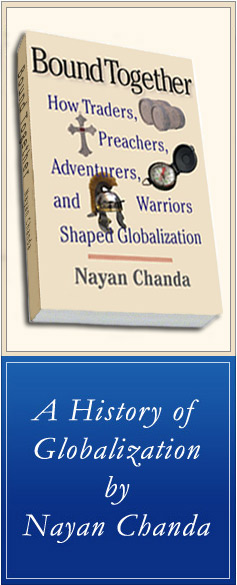Newsweek
Making Connections
Nayan Chanda draws on examples from his own life to
demonstrate how inextricably the world is linked
—Jeffrey N. Wasserstrom
June 4, 2007 issue: Rarely has there been as neat a fit between a
book's subject and its author's biography as in "Bound Together: How
Traders, Preachers, Adventurers, and Warriors Shaped Globalization" by
Nayan Chanda (372 pages. Yale University Press). It's easy to see why
the subject fascinates Chanda; he's a self-proclaimed Francophile of
South Asian origin, who studied French in Calcutta, then took courses
on China in Paris, wrote a noteworthy book about Southeast Asia, ran
a magazine in Hong Kong and ended up launching an online journal
devoted to globalization at a venerable Ivy League institution. And in
this engaging analysis, he answers such intriguing questions as "How
did the coffee bean, first grown only in Ethiopia, end up in our coffee
cups after a journey through Java and Colombia?"
In examining these specific questions—and larger ones about how the world is interconnected—Chanda does not emphasize his own experiences. But when appropriate, he effectively uses small, personal details to cut very big social, economic, cultural and sometimes biological processes down to size. For instance, he uses an account of having his own DNA analyzed to illustrate just how long migration has been central to the human experience. He also shows how close scrutiny of the iPod he gave his son as a birthday present can reveal much about the multinational origins of such objects. It was officially touted as "designed" by an American company and "assembled in China"; he found that it actually contained component parts and software with ties to India, Japan, South Korea and Scotland. And he marvels at the speed with which it traveled from Shanghai to New Haven via Alaska and Indiana, as well as at his ability to track its progress thanks to bar codes.
The debate over globalization has grown so polarized that many readers a re probably itching to know whether Chanda belongs in the "pro" or "anti" camp. One theme of "Bound Together" is that thinking in these terms doesn't make sense. Those who gather at what are somewhat misleadingly called "anti-globalization" rallies, after all, don't oppose all the ways the world is shrinking, just some (they're content to play world music at their protests, for instance). And their campaigns make use of many technologies (notably the Internet) that are crucial to 21st-century-style globalization.
Indeed, Chanda's stand on the subject might be called that of a cautiously optimistic fatalist. Neither a starry-eyed apologist nor a virulent critic, he asserts that the only reasonable response to globalization is twofold: accept that the world is not going to stop shrinking and figure out ways to maximize the positive and minimize the negative effects. He acknowledges the downsides of globalization (social inequities, the spread of new diseases and so on), yet argues that in many ways being "bound together" ever more tightly can ultimately be a good thing, benefiting more and more individuals and groups.
To be sure, the most gung-ho global boosters may feel let down by Chanda's "on the one hand this, but on the other hand that" approach. And others may think, as I do, that he veers too close to a sort of free-market fundamentalism in stressing that globalization can create a rising tide that will lift most boats. There are also some missed opportunities, especially regarding the cultural side of globalization. I, for one, would have loved to see him take the story of his son's iPod one step further and look at the songs on it. Downloading the Beatles, after all, is an exercise in globalization: a British band influenced by American rhythm and blues with African roots whose lead guitarist developed a fondness for the Indian sitar.
Still, this is a book filled with fascinating information. And Chanda makes the most of his training as both a journalist and a scholar, bringing to his tale a reporter's eye and sense of pacing as well as an impressive breadth of knowledge. Even readers who disagree with his claims will come away with a host of new facts to draw upon—such as the fact that while Asia is often seen as the starting point for new diseases, it has traditionally been the source of inoculations as well, including one for smallpox. They will also learn a lot about the history and deployment of the term globalization, to which Chanda devotes an excellent chapter, complete with an eye-catching graphic, that charts the rapid rise to ubiquity of this slippery and, until very recently, little-used term. In addition, many will never look at an iPod in quite the same way again.
—Wasserstrom teaches history at the University of California, Irvine, and is the author of "China's Brave New World—And Other Tales for Global Times," published next month by Indiana University Press.